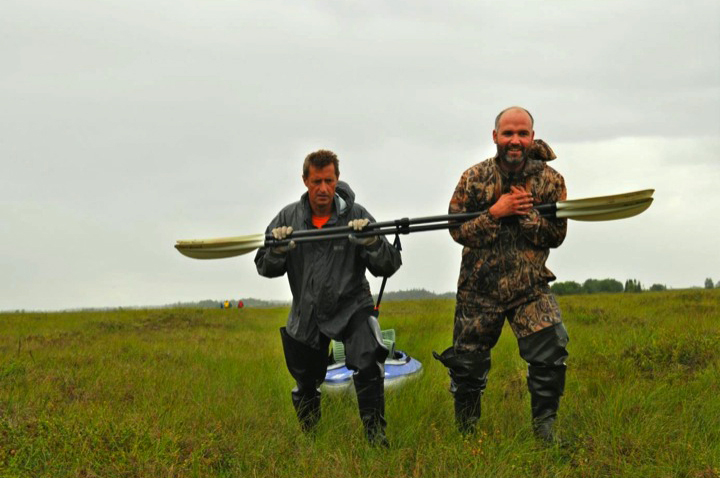An expedition by a celebrated Russian polar explorer traces old trade routes in Alaska
In this new era of a cooling relationship between the U.S. and Russia, one adventurous Russian historian is trying to warm it up a little, at least with one of its states – Alaska.
Dr. Mikhail Malakhov, Russia’s most celebrated polar explorer, is returning to Alaska this month for the ninth time in almost as many years, to undertake another grueling expedition retracing portage and trade routes used by early Russian explorers, particularly in Southwestern Alaska. This year he, his two sons and six other adventurers will kayak from Dillingham on the Nushagak River, up through the Wood-Tikchik State Park to its upper reaches on Nishlik Lake and then portage over the Kilbuck mountains to the Aniak River, ending their quest in the village of Aniak on the Kuskokwim River in mid-August.

Malakhov’s trip honors his Russian forebear, Fedor Kolmakov, who established a trading post on the Nushagak River 200 years ago next year. From this location the fur trade and the Russian Orthodox religion spread throughout Southwestern Alaska.
First, a little about Malakhov. According to his online biography, he was the first person to plant a Russian flag on the North Pole, a place he has skied to 16 times. One of these was a fabled expedition in 1995, when he and Canadian Peter Weber were the first to achieve the Holy Grail of polar exploration — a round-trip journey on foot to the North Pole without being resupplied or aided by support teams. The extraordinary feat was recounted in the jointly authored book “Polar Attack.” Their successful venture cast even more doubt on Robert Peary’s claim to have reached the Pole in 1909. For this and other Arctic accomplishments, Malakhov was honored as a Hero of the Russian Federation, the highest award Russia bestows for heroic acts.
[When an off-course U-2 spy plane out of Alaska nearly triggered war]
Malakhov is from the Ryazan area of Russia, the home of Lavrently Zagoskin, one of the great explorers of Russian America. Zagoskin’s journal of his travels in Alaska’s Y-K Delta from 1842 to 1844 remains a seminal work of Alaska history and ethnography.

According to Malakhov, Zagoskin’s accomplishments, along with those of many other Russian explorers and settlers of Alaska, have dimmed in the consciousness of his countrymen. Malakhov has dedicated himself to bringing attention to these early exploits — first, by restoring Zagoskin’s home in Ryazan as a museum for Russian American explorations, and, second, by duplicating these journeys in Alaska.
Malakhov has now led eight grueling expeditions under sponsorship by the Russian Geographical Society and others to our state to experience the routes used by his forebears as they did – by boat, kayak and foot. His travels always include his two sons and a score of other participants.
Malakhov’s first expedition in 2009 was by kayak down the Yukon from Nenana into Norton Sound and ending at St. Michael, Zagoskin’s base and the most important Russian outpost in Western Alaska. He returned five more times: 2010 — exploring settlements and portages between the Yukon and Kuskokwim rivers; 2011 — kayaking up the Nushagak River from Dillingham and portaging to the Kuskokwim and Yukon Rivers ending at Russian Mission; 2012 — kayaking portions of the Copper River and the Innoko River; 2013 — sailing from Kodiak to Attu; 2015 — walking from Williamsport to Lake Iliamna and kayaking down the lake and up the Naknek River before portaging through the Alaska Peninsula to Egegik on Becharof Lake. Last year he sailed around Kodiak Island to examine the life and influence of St. Herman, and then by kayak and foot retraced old portage routes on the island.

At a small gathering in Anchorage just before Malakhov’s return to Russia in 2015, he explained how all of these journeys retrace routes traveled by early Russian explorers. The trips have been long, strenuous and at times dangerous, but buoyed by welcome visits to villages and communities along the way. He and his fellow travelers were surprised to find that, despite the dark moments in the history of Russian colonization, many of the places they visited on their expeditions valued their Russian heritage. He found a shared history that connected him and his companions to many of the people who invited them into their villages and homes, often for days, putting them behind their demanding schedule. Malakhov has even been able to reciprocate having hosted school children from the village of Kalskag at his home in Ryazan.
The driving ambition behind Malakhov’s expeditions is to create awareness in his own country of Russian America, but he also wants to foster good relations between Alaskans and Russians — people to people, if not government to government — because we share a common history and, in many families, a common ancestry. These ambitions couldn’t be more timely as Alaskans observe the 150th anniversary of the Alaska purchase this year. Welcome back Dr. Malakhov.
Tim Troll is executive director of the Bristol Bay Heritage Land Trust, an organization dedicated to preserving the wildlife habitat, culture and history of the Bristol Bay region.